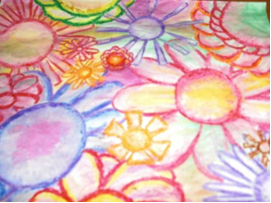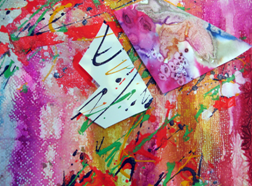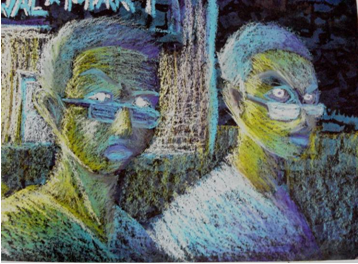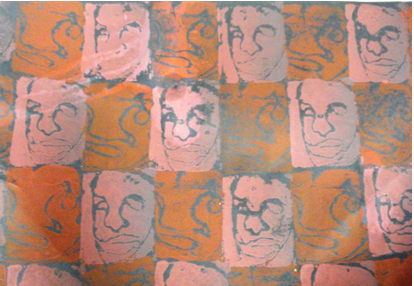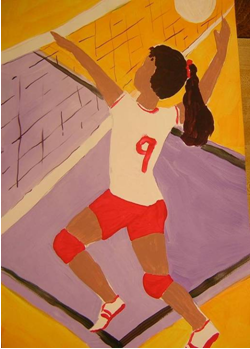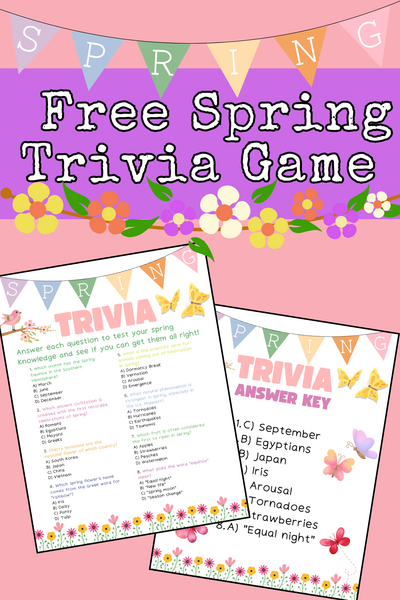Learning to See Abstractly
From Direct Observation to Abstraction: Learning to See Abstractly

Target Group: Grades 9-12
Goal (Terminal Objective): Students will demonstrate a visual understanding of Abstract Art by completing a personal and expressive composition originating from a direct observation experience with this lesson from Sargent Art.
Objective: Beginning with a straight forward line drawing from direct observation, students will creatively develop a new abstract composition using the lines and shapes from their original drawing as a visual resource.
National Standards:
Visual Arts Grades 9-12 Content Standard 1: Understanding and applying media, techniques, and processes
Visual Arts Grades 9-12 Content Standard 2: Using knowledge of structures and functions
Visual Arts Grades 9-12 Content Standard 3: Choosing and evaluating a range of subject matter, symbols, and ideas
Visual Arts Grades 9-12 Content Standard 4: Understanding the visual arts in relation to history and cultures
Purpose: Students will look at examples of abstract art from its emergence to the present. Students will learn to look at ordinary objects in a new aesthetic way and simplify their vision into a pleasing abstract composition with emphasis placed on line, shape, and color.
New Vocabulary:
Abstract Art: works of art that depict natural objects in simplified, distorted, or exaggerated ways
Aesthetics: an awareness of beauty or an awareness of the quality in a work of art that evokes a sense of elevated awareness (aesthetic experience)
Materials:
- Sargent Art Watercolor Pencils, #22-7205
- Sargent Art Watercolor Crayons, #22-1112
- Sargent Art - 16 ct. Semi-moist Watercolors, #22-8426
Time: Approximately 1 week of class time (4-6 hours)
Introduction & Motivation (Set):
Teacher will give an explanation of abstract art by showing examples ranging from early 20th century to modern abstraction. Some good artists to focus on are Paul Klee, Theo van Doesburg, Piet Mondrian, Alfred Gockel, and Nancy Graves. Show a range from objective abstraction to completely non-representational abstraction. It is always interesting to hear the opinions of high school students who are newly introduced to abstract art! Engage them in an aesthetics discussion.
Instruction:
1. Students begin with a contour line drawing of ordinary objects found around the classroom. Let them find their own things and arrange their own still life at their work station. The choice of the objects isn’t important, but they should arrange them in a pleasing manner.
2. Upon completion of the contour line drawing from direct observation, students will make a viewfinder (square or circle - 3-5” cut out of an 8 1/2 x 11” piece of copy paper is fine) to use as a “zoom-in tool” to find areas of their drawing with interesting lines and shapes. Stress the importance of stopping the viewfinder on an aesthetically pleasing, primarily nonobjective area of the composition. The idea of this project is to simplify the subject down to basic elements of design -- hence the abstraction is born!

Abstract composition chosen through the circular window of the viewfinder
Note: You may choose for them to do more than one abstraction from the same original contour line drawing. Just repeat step 2 to lay out 2-4 abstract studies.
3. Students will use Sargent watercolor products to add original, creative color to their new abstract compositions. Watercolor crayons and the traditional watercolor tray set work well for larger shapes, while the watercolor pencils are a great product to achieve smaller line work and detail within the project. Teacher may choose to limit their choice of colors or instruct them to use specifically warm, cool, analogous, complementary, etc. Teacher may also guide students in a warm-up practice exercise teaching them basic watercolor technique before allowing them to complete their final projects.
4. For presentation, these finished compositions look lovely mounted on coordinating colored paper.
Activities:
(1) Guided Practice:
1. Students aesthetically scan and discuss images shown by teacher.
2. Students create contour line drawings of ordinary objects found around the room.
3. Students create a viewfinder window to explore and see new abstract possibilities from the lines and shapes in their contour drawings from direct observation.
4. Students use Sargent watercolor products to complete a technique practice exercise.
5. Students use Sargent watercolor products to add creative, individually chosen colors to their new abstract compositions.
6. Clean up with soap and water.
(2) Independent Practice & Check for Understanding:
1. Teacher circulates and visually checks for students demonstrating their understanding of project objectives and techniques.
2. Teacher provides one-on-one help to students as they work.
(3) Closure:
1. Students choose a coordinating color to mount their finished compositions.
2. Students write a reflection about which abstract work of art seen in class most influenced them in their own project choices.
Evaluation: Display finished projects in class and conduct a class critique using the following guidelines:
Level One -- The contour line drawing is completed with sound direct observation skills demonstrated. The abstract compositions chosen from within display a strong awareness of good composition and challenge the individual artist. Technique ability of the Sargent watercolor products and craftsmanship are excellent.
Level Two -- The contour line drawing is completed with good direct observation skill demonstrated. The abstract compositions chosen from within show a good understanding of composition. Technique ability of the Sargent watercolor products and craftsmanship are good.
Level Three -- Effort is shown in the completion of the contour line drawing. The technique ability of using the Sargent watercolor products is fair and craftsmanship is variable.
Level Four -- Little effort is obvious in the completion of the contour line drawing. Technique ability of the Sargent watercolor products and craftsmanship is poor.
Extension: This project could be easily incorporated into a unit on Color Theory. The abstract compositions could each visually demonstrate a specific color scheme.
Read NextChristmas Placemat
Your Recently Viewed Projects
Report Inappropriate Comment
Are you sure you would like to report this comment? It will be flagged for our moderators to take action.
Thank you for taking the time to improve the content on our site.

